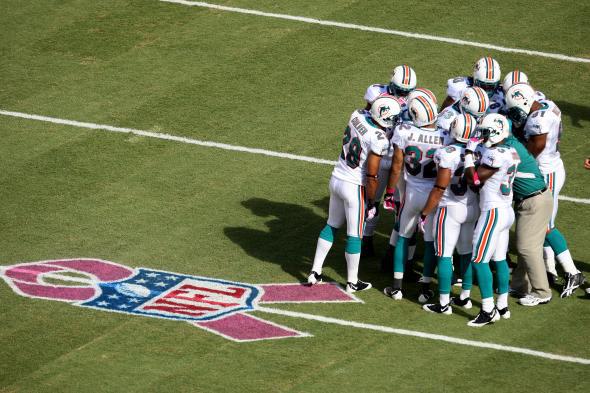Welcome to October, the month when America is painted pink to raise awareness for breast cancer—and for the companies that lay the color on thickest. Ryan Basen at Sports on Earth dives into the NFL’s campaign against breast cancer, “A Crucial Catch,” and questions whether the effort is more effective saving women’s lives or at “raising awareness” about just how charitable and woman-friendly the league is. Basin posits that “the NFL and its corporate partners are more concerned with enhancing their public images—especially among women—and ultimately revenues, than they are with addressing breast cancer, and they seek to manipulate NFL fandom in the name of public health”—with an assist from corporate partners like Pepsi, Ticketmaster, and Barclays.
A Crucial Catch’s annual effort includes stenciling football fields with breast cancer ribbons, recruiting star athletes to don baby pink in commercials supporting the effort, and selling fans on rose-tinted team-branded gear. Some of the proceeds of those sales are donated to the American Cancer Society, but “the league declines to say” the percentage it’s actually forking over—and either way, the apparel conveniently promotes the Giants and the Cowboys (and specifically encourages female investment in those brands) alongside women’s health. One particularly grim stat: Ticketmaster capped its 2012 A Crucial Catch donation at $40,000. That’s just $1 for every woman who died of breast cancer in 2012; one study found that patients with metastatic breast cancer cost the U.S. a combined $12.2 billion annually in direct and indirect costs. As Basen puts it: “You’d need to use scientific notation with negative exponents to express what percentage of the NFL’s annual revenues it contributes via A Crucial Catch.” But the on-field pink ribbons loom large.
The NFL’s effort also focuses specifically on “the importance of annual screenings” for the disease, “especially for women who are 40 and older,” as recommended by the American Cancer Society. But some researchers dispute the efficacy of yearly screenings for women at normal risk of breast cancer, which can lead to unnecessary and invasive treatments. One recent study suggested that a mammogram every two years is the optimal schedule for women between the ages of 50 to 74. How best to allocate funds to prevent and treat breast cancer is a controversial subject among scientists and public health advocates, and the NFL’s campaign imbues the league with significant influence over the debate (while it drums up support for its own product). The NFL effort is particularly effective “because, just as sports stars can persuade us to buy Gatorade and Nikes, research has shown they are effective at influencing consumers’ beliefs and actions concerning our health,” Basen writes.
The efficacy of the NFL’s campaign is worth debating because it does not occur within a vacuum. Americans do not have limitless attention spans or funds to devote to causes they support. The NFL’s campaign is so pervasive that it may even affect the efforts of other organizations hoping to raising awareness (and money) this month. As Ann Freidman reports at the Cut, the “anti-domestic violence movement staked its claim to October way back in 1981,” signified by its own purple ribbons, but it’s since lost the annual conversation to breast cancer pink. When did National Coalition Against Domestic Violence executive director Rita Smith know it was over? When she “was watching football in 2009” and “she noticed—as if it were possible not to—that the players were newly outfitted in pink socks and gloves. Her heart sank. ‘I was pretty sure we were toast,’ she says. ‘There was no way we were ever gonna match them.’ ”
